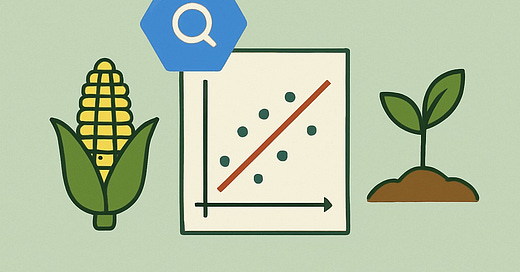Performing Linear Regression in Agricultural Science Using BigQuery: A Complete Guide with Simulated Data
This article demonstrates how to simulate data and perform linear regression in BigQuery to model wheat yield based on fertiliser input, showcasing a scalable, SQL-based approach for modern agricultural analytics.
Download all articles from: Mini Recipes on Advanced Data Analysis & Machine learning using Python, R, SQL, VBA and Excel
Introduction
In recent years, agriculture has seen a rapid transformation due to advancements in data collection, processing, and analytics. From drones and sensors to weather APIs and IoT devices, modern farming operations produce vast amounts of structured data. Extracting insights from this data is critical to improving productivity, reducing costs, and enhancing sustainability.
One foundational analytical method in this domain is linear regression—a simple yet powerful tool that helps quantify relationships between variables. For example, how does fertilizer application impact wheat yield?
While tools like Excel, Python, or R are commonly used for linear regression, Google BigQuery offers a compelling alternative for data analysts working in cloud environments. In this article, we will show you how to simulate agricultural data, perform a complete linear regression analysis, and make predictions using pure SQL in BigQuery.
Keep reading with a 7-day free trial
Subscribe to AI, Analytics & Data Science: Towards Analytics Specialist to keep reading this post and get 7 days of free access to the full post archives.




